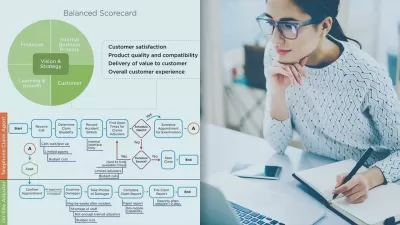Business Analysis: Data Flow Diagrams to Visualize Workflows
Tom and Angela Hathaway
2:22:50
Description
Process Modeling Techniques for Requirements Elicitation and Workflow Analysis
What You'll Learn?
- Document existing business processes and workflows in Data Flow Diagrams (DFD) to initiate business process analysis
- Defend the need for Data Flow Diagrams, Context Diagrams, and Rigorous Physical Process Models
- Use the right symbols for each type of diagram to ensure a common interpretation by all parties
- Explode a high level Data Flow Diagram to its lower level details to reveal underlying processes and procedures
- Balance DFD’s to identify missing processes and reduce late project change requests
- Use Horizontal Balancing to discover missing data and minimize redundancies
- Document process specifications for functional primitives to guide the solution providers
- Express metadata to reveal informational details that developers need to build the solution
- Apply workflow analysis techniques to reveal the cause of business problems, timing anomalies, and error/exception handling processes.
- Leverage the results of workflow analysis to elicit requirements, user stories, scenarios, features, etc.
Who is this for?
What You Need to Know?
More details
DescriptionDo you want to visualize your workflows and business processes to simplify the requirements discovery process? Or maybe you want a more efficient workflow, but you don’t know where to start? This course is for you!
Learn how to:
Create Data Flow Diagrams (DFDs) and Context Diagrams from your current process workflows
Visualize business needs, analyze business problems, discover timing anomalies, and optimize exception/error handling
Create a holistic picture of requirements, user stories, features, etc. that increases the buy-in of all stakeholders
----------
Use Data Flow Diagrams to Visualize Workflows
Getting from someone's explanations of how they do their job to usable and accurate workflow descriptions can be a daunting proposition. Understanding current workflows, however, is critical to defining a future digital solution. Just as critical is understanding how data is created and consumed throughout the workflow.
To truly understand problems inherent in a business process or workflow, you need to help the domain experts, business analysts, and developers visualize what they do. Data Flow Diagrams are phenomenal tools for visualization.
Working with business experts, you can help them discover problems and inefficiencies they don’t even know they have. These are not people problems; they are process problems. Understanding when and how to create and use Data Flow Diagrams will help you discover and capture the requirements for improving the use of information technology.
Combined with workflow analysis techniques, DFDs optimize your workflows and reveal Requirements, User Stories, Features, Scenarios, or whatever mode you use to describe desired business outcomes of software.
----------
Who Needs DFDs Today?
Data Flow Diagrams (also written Dataflow Diagrams) are a method for depicting the sources, transportation, transformation, storage, and consumption of data in a business process. These are not just tools for data analysts and software developers.
In our extensive experience, DFDs are tools of visual communication among domain experts (aka Subject Matter Experts or SMEs) and the Information Technology (IT) group. Having used them in hundreds of requirements discovery and user story workshops over the years, we have yet to find a better tool for encouraging productive discussions about workflows and how individual departments interact.
In addition, many organizations are undergoing digital transformation that relies on Big Data. Artificial Intelligence, Machine Learning, and Deep Learning depend also on reliable, accurate, and accessible data. Since bad data leads to bad outcomes, the ideal time to ensure the requisite level of quality is when the data is created. A Data Flow Diagram is an optimal tool for analyzing and improving data quality at the time of creation.
----------
Why Should You Buy This Course?
This course includes the most complete, in-depth Data Flow Diagram tutorial that helps you remove workflow process problems and clarify complex requirements.
Fully updated with tons of new content.
Includes Student Handout in .pdf format for notetaking
"Intellimated" video lectures use visual representations to simplify complex concepts and associations.
Quizzes and assignments give you an opportunity to test your understanding of the presented material, reinforce learning, and increase retention.
Help from the authors to clarify open questions and provide additional information.
Lifetime access to the course including future updates.
30-day Moneyback guarantee backed by Udemy if you are not completely satisfied with the learning experience.
You will gain confidence in your ability to leverage the power of User Stories to minimize miscommunication that plagues IT initiatives.
----------
About the Course
You will learn the benefits of process visualization for the business community, for the one wearing the Business Analysis or Product Owner hat, for those tasked with developing the solution, and ultimately for the entire organization.
You will also discover that DFDs are powerful tools for recognizing and solving some major problems that haunt IT projects, such as scope creep, project overruns, and missing or misunderstood requirements.
“Business Analysis: Data Flow Diagrams to Visualize Workflows – Simply Put!†uses a concrete business scenario to present a simple, easy-to-learn approach using interviews with domain experts to create and analyze Data Flow Diagrams depicting workflow and data manipulation.
You will learn step-by-step how to create a Context-Level Data Flow Diagram and explode relevant process(es) to reveal the nitty-gritty detail (i.e., individual process and data specifications) that developers need to create IT solutions that the business community needs.
The course also covers how to do workflow analysis using a DFD that delivers Requirements, User Stories, Features, Scenarios, or whatever mode you use to describe desired business outcomes of software products.
The course answers the following questions:
What is a Data Flow Diagram (DFD)?
What is a Rigorous Physical Process Model?
What is a Context-Level DFD?
Why should I use Data Flow Diagrams?
What symbols can I use on each type of diagram?
How can I drill down into a process?
How can I show internal processes and flows that produce the results?
What does balancing a Data Flow Diagram mean and what is the business value?
What is the most efficient approach to balancing a DFD?
What business value do process specifications offer?
How can I express detailed specifications for processes and data?
What is “metadata" and why do you need it?
What does a fully balanced DFD look like?
What value does a DFD fragment provide?
How can I visualize what’s wrong with my current workflows?
How does a DFD help me get requirements or user stories?
Regardless of your job title or role, if you are tasked with identifying business process improvements or functional requirements, this course is for you.
----------
About the Instructor
Teaches 18 Udemy courses for Agile Business Analysis with over 65,000 students enrolled.
Champions lean and agile methods to meet communication challenges between business and IT communities.
Extensive YouTube Channel with 121 videos for 18K subscribers and 1.7M views.
Authored 11 Business Analysis books covering tools and techniques for Agile and traditional software requirements.
Consultant to a multitude of Fortune 500 companies and governmental agencies.
Facilitated 100’s of User Story and Requirements Gathering Workshops for multi-million-dollar projects.
25+ years’ experience with instructor-led training for tens of thousands of students around the world.
· Coach and mentor for aspiring business analysts.
Intrigued but not convinced? Take a look at our FREE previews to make sure my instructor style and delivery work for you.
Who this course is for:
- Business Analysts
- Subject Matter Experts
- Agile Product Owners
- Project Leaders and Managers
- Line Managers
- Systems Analysts
- Software Testers
- Business Architects
- AND "anyone wearing the business analysis hat"
Do you want to visualize your workflows and business processes to simplify the requirements discovery process? Or maybe you want a more efficient workflow, but you don’t know where to start? This course is for you!
Learn how to:
Create Data Flow Diagrams (DFDs) and Context Diagrams from your current process workflows
Visualize business needs, analyze business problems, discover timing anomalies, and optimize exception/error handling
Create a holistic picture of requirements, user stories, features, etc. that increases the buy-in of all stakeholders
----------
Use Data Flow Diagrams to Visualize Workflows
Getting from someone's explanations of how they do their job to usable and accurate workflow descriptions can be a daunting proposition. Understanding current workflows, however, is critical to defining a future digital solution. Just as critical is understanding how data is created and consumed throughout the workflow.
To truly understand problems inherent in a business process or workflow, you need to help the domain experts, business analysts, and developers visualize what they do. Data Flow Diagrams are phenomenal tools for visualization.
Working with business experts, you can help them discover problems and inefficiencies they don’t even know they have. These are not people problems; they are process problems. Understanding when and how to create and use Data Flow Diagrams will help you discover and capture the requirements for improving the use of information technology.
Combined with workflow analysis techniques, DFDs optimize your workflows and reveal Requirements, User Stories, Features, Scenarios, or whatever mode you use to describe desired business outcomes of software.
----------
Who Needs DFDs Today?
Data Flow Diagrams (also written Dataflow Diagrams) are a method for depicting the sources, transportation, transformation, storage, and consumption of data in a business process. These are not just tools for data analysts and software developers.
In our extensive experience, DFDs are tools of visual communication among domain experts (aka Subject Matter Experts or SMEs) and the Information Technology (IT) group. Having used them in hundreds of requirements discovery and user story workshops over the years, we have yet to find a better tool for encouraging productive discussions about workflows and how individual departments interact.
In addition, many organizations are undergoing digital transformation that relies on Big Data. Artificial Intelligence, Machine Learning, and Deep Learning depend also on reliable, accurate, and accessible data. Since bad data leads to bad outcomes, the ideal time to ensure the requisite level of quality is when the data is created. A Data Flow Diagram is an optimal tool for analyzing and improving data quality at the time of creation.
----------
Why Should You Buy This Course?
This course includes the most complete, in-depth Data Flow Diagram tutorial that helps you remove workflow process problems and clarify complex requirements.
Fully updated with tons of new content.
Includes Student Handout in .pdf format for notetaking
"Intellimated" video lectures use visual representations to simplify complex concepts and associations.
Quizzes and assignments give you an opportunity to test your understanding of the presented material, reinforce learning, and increase retention.
Help from the authors to clarify open questions and provide additional information.
Lifetime access to the course including future updates.
30-day Moneyback guarantee backed by Udemy if you are not completely satisfied with the learning experience.
You will gain confidence in your ability to leverage the power of User Stories to minimize miscommunication that plagues IT initiatives.
----------
About the Course
You will learn the benefits of process visualization for the business community, for the one wearing the Business Analysis or Product Owner hat, for those tasked with developing the solution, and ultimately for the entire organization.
You will also discover that DFDs are powerful tools for recognizing and solving some major problems that haunt IT projects, such as scope creep, project overruns, and missing or misunderstood requirements.
“Business Analysis: Data Flow Diagrams to Visualize Workflows – Simply Put!†uses a concrete business scenario to present a simple, easy-to-learn approach using interviews with domain experts to create and analyze Data Flow Diagrams depicting workflow and data manipulation.
You will learn step-by-step how to create a Context-Level Data Flow Diagram and explode relevant process(es) to reveal the nitty-gritty detail (i.e., individual process and data specifications) that developers need to create IT solutions that the business community needs.
The course also covers how to do workflow analysis using a DFD that delivers Requirements, User Stories, Features, Scenarios, or whatever mode you use to describe desired business outcomes of software products.
The course answers the following questions:
What is a Data Flow Diagram (DFD)?
What is a Rigorous Physical Process Model?
What is a Context-Level DFD?
Why should I use Data Flow Diagrams?
What symbols can I use on each type of diagram?
How can I drill down into a process?
How can I show internal processes and flows that produce the results?
What does balancing a Data Flow Diagram mean and what is the business value?
What is the most efficient approach to balancing a DFD?
What business value do process specifications offer?
How can I express detailed specifications for processes and data?
What is “metadata" and why do you need it?
What does a fully balanced DFD look like?
What value does a DFD fragment provide?
How can I visualize what’s wrong with my current workflows?
How does a DFD help me get requirements or user stories?
Regardless of your job title or role, if you are tasked with identifying business process improvements or functional requirements, this course is for you.
----------
About the Instructor
Teaches 18 Udemy courses for Agile Business Analysis with over 65,000 students enrolled.
Champions lean and agile methods to meet communication challenges between business and IT communities.
Extensive YouTube Channel with 121 videos for 18K subscribers and 1.7M views.
Authored 11 Business Analysis books covering tools and techniques for Agile and traditional software requirements.
Consultant to a multitude of Fortune 500 companies and governmental agencies.
Facilitated 100’s of User Story and Requirements Gathering Workshops for multi-million-dollar projects.
25+ years’ experience with instructor-led training for tens of thousands of students around the world.
· Coach and mentor for aspiring business analysts.
Intrigued but not convinced? Take a look at our FREE previews to make sure my instructor style and delivery work for you.
Who this course is for:
- Business Analysts
- Subject Matter Experts
- Agile Product Owners
- Project Leaders and Managers
- Line Managers
- Systems Analysts
- Software Testers
- Business Architects
- AND "anyone wearing the business analysis hat"
User Reviews
Rating
Tom and Angela Hathaway
Instructor's Courses
Udemy
View courses Udemy- language english
- Training sessions 28
- duration 2:22:50
- English subtitles has
- Release Date 2022/11/22











